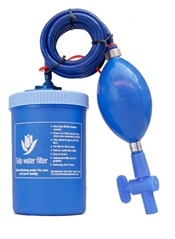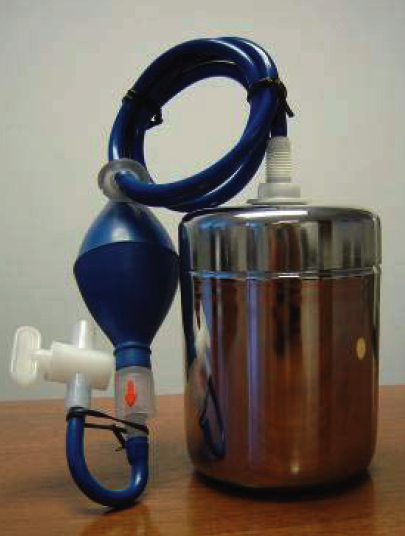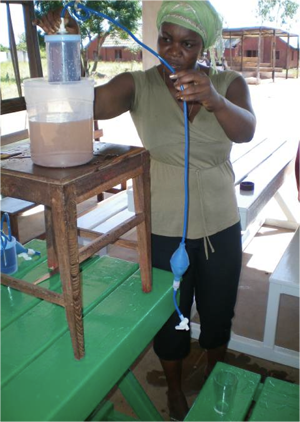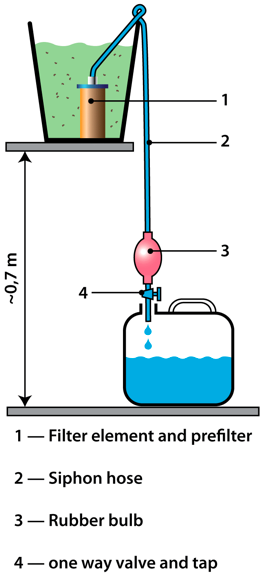Siphon filter
| |
|
|
|
|
|
|
|
|
|
The Siphon filter is a candle-type water filter which uses siphon pressure to force water through a high-quality ceramic filter element. The innovative usage of the siphon results in a high flow rate of 4-6 liters per hour. The Siphon filter is very compact, as only a filter element, a plastic hose, and a valve are needed, while existing storage containers can be used. A washable fabric is used as a pre-filter before the water enters the ceramic element. Therefore, protecting the ceramic filter from premature clogging when using turbid water. The filter is designed as a point-of-use filter in households. The filter element is impregnated with silver in order to increase the efficiency of the filter.
Contents
[hide]Suitable conditions
| Advantages | Disadvantages |
|---|---|
| - Easy to use: after 15-20 litres, the upper container has to be refilled - Colloidal silver creates some residual effect for 7.000 litres |
- Clogging if water contains fine silts - No indicator/warning system for user when leakage occurs |
|
|
Construction, operations and maintenance
Operation
The filter element is placed in a container with contaminated water, situated about 70 cm above the clean water container. The siphon action is started by squeezing the rubber bulb. The siphon pressure forces the water through the filter element, ensuring a high flow of water.
Manufacturing
The Siphon filter was developed and is now produced by Basic Water Needs India, a company based in the Netherlands, with a factory in Pondicherry, India. The ceramic filter is quite fragile, the plastic is robust. Before 2011, leakage problems were solved by gluing the candle caps under strict quality control, however newer models do not have this leakage problem. Plastic bulbs are made in one piece from EVA (material used in hospitals for plastic hoses).
It is not possible to produce the filter locally due to a lack of quality control and unavailability of raw materials or sometimes only the initial investments needed for this. It is possible however, to import the filter elements and assemble these into local plastic parts. This is always done in cooperation with and under the quality control of Basic Water Needs. Local production will be applicable if there’s existing industrial infrastructure. Other products made with the ceramic filter element is the Tulip Table Top water filter and Tulip Group filter.
Treatment Efficiency
The Siphon filter has been tested using a certified method by “Waterlaboratorium Noord”, an independent laboratory based in the Netherlands. It was found that even after passing 7000 liters of heavily contaminated water, the filter still removed E. Coli by more than 99.99%. The E. Coli test is used as an indicator for the removal of pathogenic bacteria in water. Water-borne bacteria are responsible for the large majority of diseases caused by contaminated water.
Maintenance
After some time, the flow rate may reduce because of clogging of the filter element. In this case, the filter can be cleaned by backwashing. This is done by closing the valve and squeezing the rubber bulb, which forces the water back through the filter element, pushing dirt particles out and unclogging the filter. This backwash option increases the lifetime of the filter element.
Estimated Lifespan
The filter element could produce up to 7.000 litres (enough for a large family for 1 year) of water before replacement. The plastic parts last up to 5 years.
Costs
| Capital cost | Operating cost | Replacement cost | Estimated 5 year cost | Cost / metre cubed treated |
|---|---|---|---|---|
| € 7 - 9 | € 2/year | $ 2 – 5 first year
$0,71 – 1,14 years after |
Figures are assuming filter replacement takes place every year but plastic parts last up to 5 years.
Field experiences
It is now being implemented in Ethiopia, Malawi, India, Indonesia, Tanzania, Mozambique, Madagascar, Kenya, Ecuador, Peru, Guatemala, Ghana and Bangladesh...
Manuals, videos and links
Videos
- Video #1: The siphon filter is a new effective and low cost water filter that eliminates turbidity and 99.99% of the bacteria. Henk Holtslag explains how it works. For more information, go to Foundation Connect International Foundation Connect International.
- Video #2: The Tulip Siphon filter. A new low cost water filter that eliminates turbidity and all bacteria. Filter capacity: 100 liters per day. Lifetime: 7000 liters. Retail price: 8 to 12 US$. More information at Foundation Connect International.
- Video #3: CrystalPur advertisement on Cambodian television.
How it works |
on Cambodian television |
Acknowledgements
- The CrystalPur filter. World Health Works (WHW), a spin-off of EnterpriseWorks/VITA, makes the CrystalPur filter, which was introduced in response to the need for low-cost domestic water filters in developing countries.
- Basic Water Needs, Waterbedrijf Groningen - invested in the development of the filter.
- Aqua for All - invested in the development of the filter.





